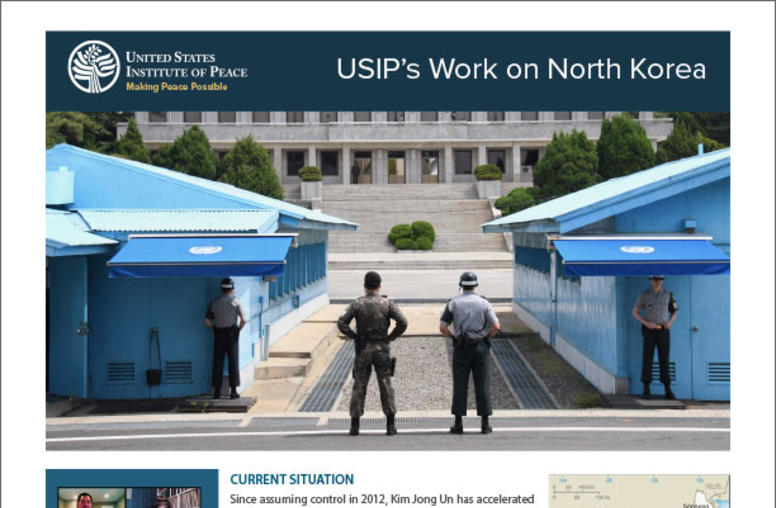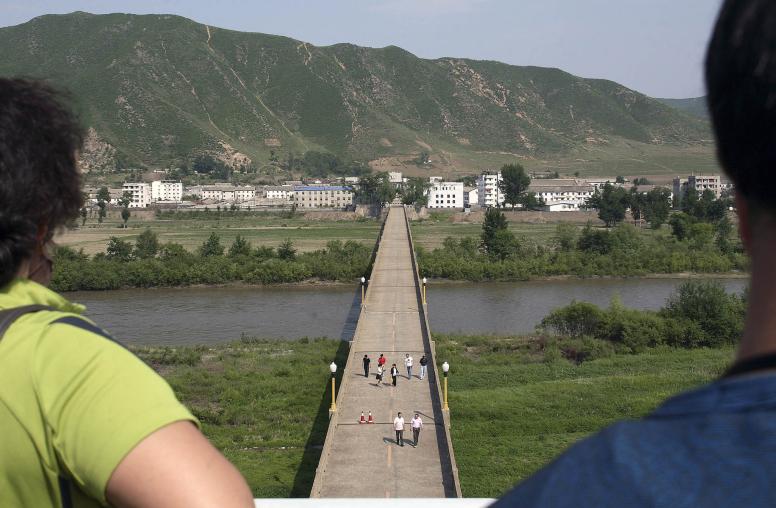The Sinking of South Korea’s Naval Vessel
The Cheonan, a 1,200-ton South Korean naval vessel, sank on March 26 when an explosion split it apart in one of the country’s worst naval disasters. North Korea has officially denied involvement and accused South Korean President Lee Myung-bak of using this tragedy to bolster support for his hard-line North Korea policy.
Posted: April 28, 2010
The Cheonan, a 1,200-ton South Korean naval vessel, sank on March 26 when an explosion split it apart in one of the country’s worst naval disasters. Of the 104-member crew, 58 were rescued soon after the sinking. Following the recent salvaging of the bow and stern sections, 40 bodies were recovered inside. Six crewmembers are still missing and presumed dead.1 North Korea has officially denied involvement and accused South Korean President Lee Myung-bak of using this tragedy to bolster support for his hard-line North Korea policy.
The Cheonan sank near the Northern Limit Line (NLL) - a disputed maritime demarcation line in the Yellow Sea - where the two Koreas have already fought three naval skirmishes since 1999. The most recent clash occurred in November and left one North Korean sailor dead and three others wounded. Unilaterally established by the U.S.-led United Nations forces in August 1953, the NLL is not officially recognized by North Korea.
USIP’s John Park answers some questions regarding the ramifications of the Cheonan incident and the impact on potential Six-Party Talks with North Korea.
- What is the impact of the Cheonan incident in terms of domestic South Korean politics?
- How will this incident affect wartime Operational Control (OPCON) transfer in 2012?
- What options are available to the South Korean government should the international investigation into the cause of the sinking determine that it was a military device?
- What are the implications for efforts to bring North Korea back to the Six-Party Talks?
- What does this all mean in terms of a future naval flare-up with North Korea?
- What is your overall assessment of the current situation?
What is the impact of the Cheonan incident in terms of domestic South Korean politics?
Given the intense South Korean media scrutiny and large loss of life, the public wants clear answers that may not come out of the international investigation as many fragments from the explosion are buried in the mud near the site where the Cheonan sank. There is a high degree of suspicion among the public, the military and the Blue House (the president’s office) that North Korea is behind the sinking of the Cheonan.
Who gets the blame and who takes responsibility are the current topics of intense debate in Seoul - tensions are growing between the Blue House and the Ministry of National Defense (MND), with each accusing the other of ineffective handling of the crisis.
As President Lee Myung-bak’s ruling conservative Grand National Party deals with the aftermath of the Cheonan incident, the June 2 local elections are likely to serve as a referendum on the Lee administration’s management of this crisis.
How will this incident affect wartime Operational Control (OPCON) transfer in 2012?
In 2007, the United States and South Korea agreed to transfer wartime Operational Control (OPCON) of South Korean forces to Seoul in April 2012. At present, if a war were to break out on the Korean peninsula, South Korean forces would be placed under the control of the Combined Forces Command, led by the U.S. Forces Korea commander.
Prior to the Cheonan incident, an influential group led by retired South Korean generals had been calling for the postponement of OPCON transfer because of their concern that it would start a process of reducing U.S. commitment to South Korean security.
Media accounts of the Blue House’s inadequate crisis response coordination and the military’s delayed reaction are calling into question the operational readiness of South Korea for OPCON transfer. The explosion that sank the Cheonan was reportedly not brought to the attention of the South Korean defense minister and the chairman of the Joint Chiefs of Staff until almost an hour after it occurred. Most damaging of all to South Korea’s credibility, sailors aboard the Cheonan apparently had to use their cell phones to alert their chain of command.
Compounding South Korean media reports about the delayed response is the growing rift between the Blue House and the MND. While overall civilian leadership and oversight of the South Korean military remains strong, the longstanding practice of appointing a retired general as the “civilian” defense minister may be reviewed. This practice is reported to have created a culture of independence on matters related to responding to direct threats to national security. Blue House management of national security crises, such as inter-Korean naval skirmishes, is reportedly viewed by the MND as meddling by nonmilitary professionals. Judging by all the recent leaks about the MND having alerted the Blue House early on regarding the strong likelihood of a North Korean attack on a South Korean naval vessel, the senior South Korean military leadership appears to be launching their own counter-attack against the Blue House’s initial claim that the MND did not perform well during the Cheonan incident. The domino effect is that this Blue House-MND skirmish is exposing what may be the weakest aspect of the U.S.-South Korea alliance – the Blue House’s coordination with the South Korean military in times of national security crises.
What options are available to the South Korean government should the international investigation into the cause of the sinking determine that it was a military device?
The Blue House is currently framing the investigation as an international effort - with investigators and experts from the United States, United Kingdom, Australia, and Sweden - to determine whether a military or nonmilitary device caused the sinking of the Cheonan. Cognizant that it’d be difficult to definitively prove that North Korea was behind the sinking, the South Korean government strategy centers on gathering as much evidence as possible in an objective manner with the international investigators. Once the investigation is completed, the South Korean government has indicated that it may bring the matter before the U.N. Security Council if it is shown that a military device caused the explosion. 2
If the Cheonan incident does make it before the U.N. Security Council, the South Korean government could call for the establishment of an international independent investigation commission, similar to the one set up under UNSC Resolution 1595 in response to the February 2005 terrorist bombing that killed former Lebanese Prime Minister Rafiq Hariri. Although there are many differences between the two cases, the main goal is similar in terms of seeking to learn who or what carried out the explosion.
What are the implications for efforts to bring North Korea back to the Six-Party Talks?
The State Department has announced that it will continue to suspend efforts to get North Korea back to the Six-Party Talks negotiating table pending the results of the Cheonan investigation.
The delayed statement of condolences from China’s Ministry of Foreign Affairs sent to the families of the Cheonan victims almost a full month after the sinking underscores Beijing’s difficult position. On the one hand, it is continuing its efforts to restart the Six-Party Talks and deepen Communist Party of China (CPC)-Workers’ Party of Korea (WPK) interactions. On the other, it is seeking to maintain good relations with both Pyongyang and Seoul. Even if Beijing is able to secure Pyongyang’s commitment to return to the Six-Party Talks, the Cheonan incident may lead to contingent delays where Seoul coordinates with Washington to link the resumption of DPRK denuclearization talks to resolution of this incident should the South Korean-led international investigation determine that North Korea is tied to the Cheonan’s sinking.
What does this all mean in terms of a future naval flare-up with North Korea?
Should (1) the Cheonan investigation finding get all the way up to the Security Council and (2) a resolution pass condemning the Cheonan’s sinking and pressuring North Korea to cooperate, North Korea is likely to increase its protests about being unfairly declared the instigator of this naval tragedy. In previous episodes, this type of North Korean protest has led to acts of North Korean brinkmanship.
With heightened South Korean anger about the Cheonan’s sinking and North Korea’s likely resumption of naval patrolling activities along the contested NLL, there’s a high potential for an escalatory naval clash. There will be few barriers or restraints – the gloves are likely to come off fast with South Korean naval commanders eager for an opportunity for retribution and the North Koreans reacting swiftly to any violations of their perceived territorial waters.
What is your overall assessment of the current situation?
South Korea’s government-led international investigation is moving closer to concluding that a military device caused the sinking of the Cheonan. However, rather than constituting definitive proof, such a finding would, in practice, significantly raise the probability of North Korea’s involvement. Many in South Korea have already reached their own conclusion - the Cheonan incident is a stark reminder that North Korea remains a clear and present danger. A growing South Korean view is that more than a decade of nuclear drama, food shortages, starvation, borderline economic collapse, and currency reform debacles, followed by bailouts from progressive South Korean governments and the Communist Party of China has made the international community complacent about the direct military threat that North Korea poses. The Cheonan is a wake-up call.
End Notes
1The U.S. Navy assisted in the rescue efforts, which later became recovery and salvage operations. http://www.pacom.us.com/PhotoArchive.aspx?id=125
2Referring to the bombing that killed Hariri, UNSC Resolution 1595 states that the Security Council decides to “establish an international independent investigation Commission…to help identify its perpetrators, sponsors, organizers and accomplices.” S/RES/1595 (2005).



